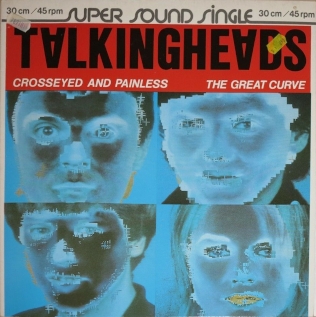Top Qs
Timeline
Chat
Perspective
Crosseyed and Painless
1980 single by Talking Heads From Wikipedia, the free encyclopedia
Remove ads
"Crosseyed and Painless" is a song by American new wave band Talking Heads. It was released in 1980 in the United States as a promotional single and in Germany in 1981 as a regular single from the band's fourth studio album, Remain in Light. Although the single failed to reach the US main chart, it reached No. 20 on the US Dance chart to become Talking Heads' highest-charting dance single. The band chose this song for their second music video, released in 1981.
Remove ads
Song style
The song uses instruments and techniques such as cowbell loops, congas, bells, staccato guitar rhythms, and electronic blips. The rhythm of the song, as well as the use of the congas, add an African feel to the song,[1] which is also apparent in their song "I Zimbra".
Lyrics
The lyrics discuss a paranoid and alienated man who feels he is stressed by his urban surroundings. These lyrics are of common theme for Talking Heads and categorize lead singer David Byrne's writing style. The "rhythmical rant" in "Crosseyed and Painless"—"Facts are simple and facts are straight. Facts are lazy and facts are late."—is influenced by old-school rap, specifically Kurtis Blow's "The Breaks" given to Byrne by Frantz.[2][page needed] The singer is filled with doubt and is not even sure he can believe facts.[3] By the end of the song, he expresses his resentment of facts: "Facts don't do what I want them to do / Facts just twist the truth around."[3]
Remove ads
Critical reception
"Crosseyed and Painless" is widely regarded as one of Talking Heads' best songs. In 2023, American Songwriter ranked the song number ten on their list of the 10 greatest Talking Heads songs,[4] and in 2024, Paste ranked the song number seven on their list of the 30 greatest Talking Heads songs.[5]
Music video
The music video for "Crosseyed and Painless", lasting 5:37, was directed by Toni Basil and by their own request did not feature the members of the band. Instead it featured street dancers (including Stephen "Skeeter Rabbit" Nichols),[6] chosen by David Byrne, and who were said to have chosen their own choreography for the video.[7] Using locking and popping techniques, the dancers engage in various dance mimes of hustling, knife crime, posing, solicitation and street fighting. The video mix includes an additional verse not heard on the LP mix of the song.
Remove ads
References
External links
Wikiwand - on
Seamless Wikipedia browsing. On steroids.
Remove ads

